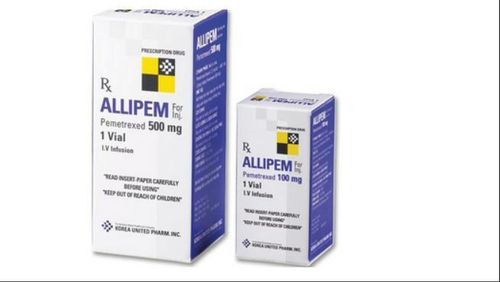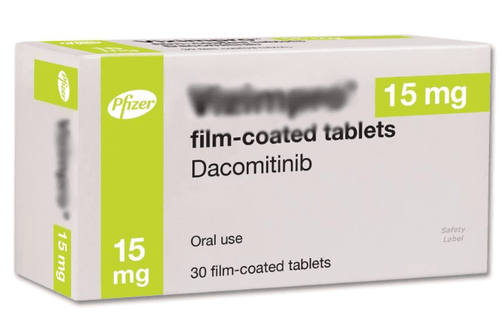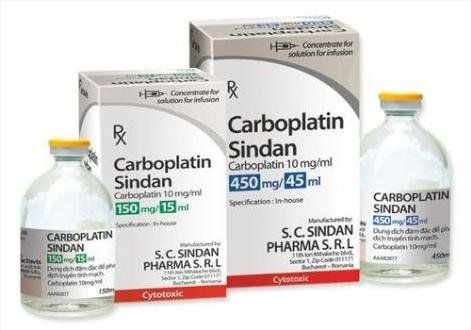This is an automatically translated article.
Moliavex is an anti-cancer drug belonging to the taxane group. So how should Moliavex be used? What precautions should be taken when using this drug? Let's find out the necessary information about the drug Moliavex through the article below.
1. Uses of the drug Moliavex
1.1 Indications Treatment of metastatic ovarian cancer when conventional therapies with anthracyclines and platinum have failed or are contraindicated. Paclitaxel is used in combination with doxorubicin as adjuvant therapy as the regimen of choice for the treatment of metastatic breast cancer. Treatment of metastatic breast cancer when conventional therapy with anthracyclines has failed or breast cancer recurs within 6 months of adjuvant therapy. Treatment of non-small cell lung cancer, AIDS-related Kaposi's cancer. 1.2 Dosage - Administration Needed: 12 hours and 6 hours before the course of treatment: dexamethasone 20 mg, orally or IV; 30-60 minutes before treatment: IV cimetidine 300 mg or ranitidine 50 mg & diphenhydramine 50 mg.
In the treatment: Paclitaxel injection 135-175 mg/m2, IV infusion over 3 hours or 24 hours, for 3 weeks. Do not repeat the dose when leukocytes < 1500/mm3, platelets < 100000/mm3.
Dosage:
The degree of response to therapy using paclitaxel depends on tumor nature, tumor volume and increasing tolerance to previous platinum-containing chemotherapy. Treatment must be carried out by a physician experienced in anticancer chemotherapy. Treatment before paclitaxel Before infusion of paclitaxel, use dexamethasone, a dose of 20 mg orally (before 12 hours and 6 hours) or intravenously (14 hours and 7 hours). In the case of HIV-infected patients, the oral dose of dexamethasone can be reduced to 10 mg. It is recommended to use diphenhydramine (50 mg intravenously, 30-60 minutes before dosing) and cimetidine, famotidine, ranitidine. Ovarian cancer:
+ First choice regimen for the treatment of advanced epithelial ovarian cancer
When cisplatin is used in combination for the initial treatment of advanced ovarian cancer, 2 paclitaxel-containing regimens are recommended. . Consideration should be given to toxicity when choosing the appropriate regimen for a patient. One regimen used paclitaxel 175 mg/m2 (body area) as an intravenous infusion over 3 hours, followed by an intravenous infusion of cisplatin 75 mg/m2, every 3 weeks. Another regimen used paclitaxel 135 mg/m2 IV 24 hours, followed by intravenous infusion of cisplatin 75 mg/m2, every 3 weeks.
+ Second-line or next-line treatment for advanced ovarian cancer
Use as monotherapy in patients with metastatic ovarian cancer who have not responded to first-line therapy or second-line chemotherapy Next, the recommended regimen of paclitaxel is 135 or 175 mg/m2 IV over 3 hours and repeated every 3 weeks if tolerated. The optimal dose of paclitaxel has not been established for this patient population.
Breast cancer:
+ Adjuvant treatment of breast cancer with lymph nodes
Use paclitaxel 175 mg/m2 intravenously in 3 hours, every 3 weeks, use 4 times, after completing doxorubicin in the regimen combination. It has been tested in numerous patients on 4 courses of doxorubicin and cyclophosphamide followed by adjuvant treatment with paclitaxel.
+ Second-line therapy for advanced breast cancer
For metastatic breast cancer that has been refractory to chemotherapy or for breast cancer that has recurred within 6 months of adjuvant therapy, administer paclitaxel through usually 175mg/m2 IV over 3 hours, every 3 weeks.
Non-small cell lung cancer:
When used in combination with cisplatin for the initial treatment of NSCLC in patients with no indication for surgery or radiation, the recommended regimen is paclitaxel 135 mg/ m2 intravenous infusion over 24 hours, then intravenous infusion of cisplatin 75 mg/m2, every 3 weeks. Another regimen, paclitaxel 175 mg/m2 intravenously over 3 hours, followed by cisplatin 80 mg/m2 every 3 weeks has also been used in patients with non-small cell lung cancer.
AIDS-related Kaposi's sarcoma:
+ For patients with advanced HIV infection, paclitaxel should only be started if the neutrophil count is at least 1,000/mm3.
+ For patients with AIDS-related Kaposi's sarcoma who have not responded to first-line regimens or next-line chemotherapy, two regimens with paclitaxel are recommended. One regimen used paclitaxel 135 mg/m2 intravenously over 3 hours every 3 weeks. Another regimen used paclitaxel 100 mg/m2 intravenously over 3 hours, every 2 weeks. These regimens have dose levels of 45 and 50 mg/m2 weekly. In phase II studies, greater toxicity was observed with high-dose regimens, and patients were worse off with paclitaxel 100 mg/m2 every 2 weeks.
The dose of paclitaxel may be reduced in patients with hepatic impairment.
In patients with a severely reduced granulocyte count (less than 0.5 x 109/liter) (500/mm3) during long-term paclitaxel therapy, the dose should be reduced by 20%. A booster course of paclitaxel should be initiated only when the granulocyte count is ≥ 1,500 cells/mm3 and the platelet count ≥ 100,000 cells/mm3. In HIV-infected patients, the paclitaxel cycle should only be repeated when the granulocyte count is at least 1,000/mm3.
How to use:
The preparation of drugs for intravenous infusion must be carried out by an experienced person in an appropriate room. When mixing the drug, it is necessary to wear gloves and proceed with caution to avoid contact with the skin and mucous membranes. If the skin is in contact with the drug, wash the skin thoroughly with soap and water; If the mucosa is in contact with the drug, rinse thoroughly with water. The drug preparation must ensure sterility. The solvent for dilution of the drug may be: 0.9% sodium chloride solution, 5% glucose solution, a mixture of 0.9% sodium chloride solution and 5% glucose solution, or a mixture of 5% glucose solution and 5% glucose solution. ringer solution. Usually the drug is mixed into one of the above solutions so that the infusion solution has a paclitaxel concentration of 0.3 - 1.2 mg/ml. Use only infusion bottles made of glass, polypropylene or polyolefin. The transmission set must be made of polyethylene. The infusion prepared as above is physico-chemically stable for 27 hours at room temperature (approximately 25°C) and under light. Administer the infusion immediately or within 3 hours after the preparation is complete. Do not keep the reconstituted infusion in the refrigerator. - During the preparation process, the infusion solution may become slightly cloudy. This is due to the solvent of the preparation, so even filtering can not make it clear. When infusion, the solution should be allowed to flow through a filter with a vial hole not larger than 0.22 micrometers on the infusion line. This does not affect the quality of the drug. Prophylaxis of hypersensitivity prior to administration of paclitaxel as well as treatment of life-threatening anaphylactic reactions. Prednisolone: 30 - 40 mg (6 - 8 tablets, 5 mg/tablet), orally 12 and 6 hours before paclitaxel infusion, plus H1 receptor antagonist e.g. Clemastin : IV infusion of 2 mg 30-60 minutes before infusion of paclitaxel (other antihistamines may be used), plus cimetidine (300 mg) or ranitidine (50 mg): IV infusion 30-60 minutes before infusion of paclitaxel .
2. Precautions when using Moliavex
Contraindications:
Do not use for patients with hypersensitivity to paclitaxel or to any component of the preparation, especially hypersensitivity to Cremophor EL oil. Note that patients are often more or less hypersensitivity to Cremophor EL oil. Do not use for patients with neutrophil count < 1500/mm3 (1.5 x 109/liter) or with obvious motor neuropathy. Pregnant or breastfeeding. Do not use in children under 18 years of age because of the lack of data on safety and effectiveness for these subjects. Note:
It is necessary to reduce the dose in patients with disorders or impaired liver function. Paclitaxel is not recommended in cases of transaminase elevations of 10 times the upper limit of normal, or bilirubin > 7.5 mg/100 ml or 5 times the upper limit of normal. Use with caution in patients with heart disease. In the preparation with the excipient is cremophor EL, which is more likely to cause anaphylactoid-type responses due to the high release of histamine in people who are hypersensitive to cremophor EL. Therefore, anaphylaxis prophylaxis should be administered prior to treatment and preparedness for anaphylactic reactions should be prepared. Caution should be exercised in patients with a history of peripheral neuropathy (chemotherapy or diabetic neuropathy). When multiple drugs are administered sequentially, taxane derivatives (paclitaxel, docetaxel) should be administered before platinum derivatives to reduce the risk of myelosuppression. The elderly are often at increased risk of toxicity (neuropathy, agranulocytosis).
3. Side effects when using Moliavex
Myelosuppression, hypotension, elevated liver enzymes, musculoskeletal pain, digestive disorders, hair loss, peripheral neuropathy.
Usually the side effects or unwanted effects (Adverse Drug Reaction (ADR) unwanted effects will go away when the drug is stopped. If there are rare side effects that are not mentioned in the leaflet. Inform your doctor or medical officer immediately if you suspect any side effects of Moliavex.
4. Drug interactions
What drugs can interact with Moliavex?
Remember that drug interactions with other drugs are often quite complicated due to the influence of many ingredients in the drug. Studies or recommendations usually only state common interactions with use. Therefore, do not arbitrarily apply information about Moliavex drug interactions if you are not a researcher, doctor or medical person.
Moliavex drug interactions with food and drinks
Consider using the drug together with alcohol, tobacco, alcoholic or fermented beverages. Factors that can change the composition of the drug. See details in the leaflet or consult your doctor or pharmacist for more details.
Please dial HOTLINE for more information or register for an appointment HERE. Download MyVinmec app to make appointments faster and to manage your bookings easily.













